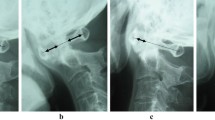Summary
Atlantoaxial (AA) instability is frequent radiological finding in patients with rheumatoid arthritis (RA). Mostly no serious neurological disorders are expected in such patients.
The purpose of the study was to assess the sagittal spinal canal diameter according to Steel’s rule of third and its relationship to clinical symptoms.
Radiological and clinical evaluation was performed in 65 in-patients with RA. Fifty four patients complained of neck pain, 39 had vertebrobasilar symptoms, and 25 mild neurological disorders. A hyperreflexy tendon responses were registered in 16 patients. Only 1 patient had extensor plantar response. Forward AA dislocation was verified in 28 (43%) cases with a mean value of 8.3mm (4–17mm). Still free space for spinal cord in spinal canal was obtained in 62 (95%) of patients, which can explain such a low incidence of serious neurological disorders.
Our results suggest an association among duration of disease, atlantodental distance, and sagittal spinal canal diameter.
We consider that it is important to detect early the most jeopardized patients on the basis of radiological analysis at C1 level according to Steel’s rule of third and recognize when „safe zone” has exceeded and enters the area of impending spinal cord compression.
Zusammenfassung
Atlantoaxiale (AA) Instablität ist ein häufiger radiologischer Befund bei Patienten mit rheumatoider Arthritis (RA). Meistens weisen diese Patienten keine ernsthaften neurologischen Störungen auf.
Die vorliegende Studie hatte zum Ziel, den saggitalen Durchmesser des Spinalkanals anhand der Steel’schen Ein-Drittel-Regel sowie die Relation dieses Parameters zur klinischen Symptomatik des Patienten zu bestimmen.
Radiologische und klinische Daten wurden bei 65 Patienten mit RA evaluiert. 54 Patienten klagten über Nackenschmerz, 39 zeigten eine vertebrobasilare Symptomatik und 25 hatten leichte neurologische Störungen. Verstärkte Sehnenreflexe wurden bei 16 Patienten registriert. Nur bei einem Patienten war die Reaktion plantarer Extensoren vorhanden (Babinsky-reflex). Die vordere AA Dislokation zeigten 28 (43%) der Patienten: die Verschiebung betrug im Mittel 8.3mm (4–17mm). Bei 62 (95%) Patienten war im Spinalkanal für das Rückenmark noch ein verbliebener freier Raum vorhanden. Dies erklärt die niedrige Inzidenz schwerwiegender neurologischer Störungen.
Unsere Ergebnisse weisen auf einen Zusammenhang zwischen der Krankheitsdauer, der atlantodentalen Entfernung und dem saggitalen Durchmesser des Spinalkanals hin. Es ist wichtig, gefährdete Patienten mit Hilfe der radiologischen Analyse des C1-Abschnitts der Halswirbelsäule frühzeitig zu erkennen. Anhand der Steel’schen Ein-Drittel-Regel kann ermittelt werden, ob die „Sicherheitszone“ im Spinalkanal überschritten ist und der Patient in den Bereich einer drohenden Rückenmarkkompression eintritt.
Similar content being viewed by others
Author information
Authors and Affiliations
Additional information
Received: 12 January 1998 Accepted: 20 May 1999
Rights and permissions
About this article
Cite this article
Babić-Naglić, Đ., Potočki, K. & Ćurković, B. Clinical and radiological features of atlantoaxial joints in rheumatoid arthritis. Z Rheumatol 58, 196–200 (1999). https://doi.org/10.1007/s003930050170
Issue Date:
DOI: https://doi.org/10.1007/s003930050170




